Chinese Medicines Help Cancer Patients to Cope With Radiotherapy
Radiotherapy works by damaging the structure of cancer cells, disabling them from reproducing and growing so as to make the cancer cells die and the tumor shrink. Applications may vary on the basis of the cancer type, cancer stage and the goal of treatment. Although the high-energy radioactive beams target specific areas of the body, many patients experience discomfort. Usually, patients do not feel anything during radiation treatment; the side effects build up over time and are typically limited to the targeted area.
The general TCM approaches in radiotherapy
In TCM understanding, radiation is a kind of toxic fire or toxic heat evil ; they exhaust the qi (vital energy) and body fluids, disturb the blood and qi production in the spleen and the stomach, and damage the liver and the kidneys. TCM has the following approaches to treat the side effects of radiotherapy:
|
Clearing heat and toxins to prevent inflammatory reactions. |
|
Nourishing yin to promote body fluid production and relieve dryness symptoms. |
|
Replenishing qi and blood to relieve fever conditions and the associated symptoms like fatigue, palpitation and dizziness. |
|
Fortifying liver and kidneys to relieve general weakness, fatigue, depression, low blood counts, palpitation and breath shortness. |
|
Invigorating spleen and harmonizing stomach to relieve digestive problems such as nausea, vomiting, poor appetite and diarrhea. |
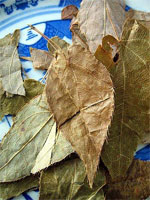 |
|
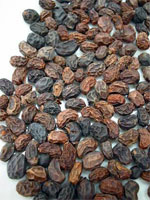 |
|
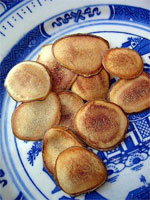 |
| Epimedium |
|
Glossy privet fruit |
|
Pilose antler |
Chinese herbs to enhance radiation efficacy
Before radiation treatment, physicians may use certain herbs to stimulate the area to be irradiated. The herbs are said to work on the site to relieve the contraction of the blood vessels, improve the micro and lateral circulations, inhibit platelet coagulation and regulate the metabolism of connective tissues, in this way, they make the cancer site more susceptible to the radiation and help optimize treatment.
Side effects associated with brain and neural tissues
This may involve symptoms like headache, nausea, vomiting and pain. TCM will focus on replenishing the essence and bone marrow, in addition to activating the flow of the meridians. Commonly used herbal ingredients are:
Side effects associated with nasal cavities
When inflammation occurs leading to symptoms like losing the senses of taste or smell, dizziness, running nose and ear ringing, TCM physicians claim that it should remove blockages of the lung openings and clear heat in the lungs. Commonly used herbs are:
cang er zi |
Siberian cocklibur fruit |
Fructus Xanthii |
xin yi |
Biond Magnolia flower |
Flos Magnoliae |
bai zhi |
Dahurian Angelica root |
Radix Angelicae Dauhuicae |
shi gao |
Gypsum |
Gypsumn Fibrosum |
bo he |
Pepper mint |
Herba Ephedrae |
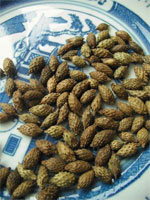 |
|
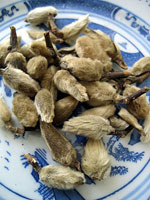 |
|
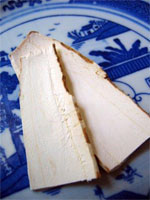 |
| Siberian cocklibur fruit |
|
Biond Magnolia flower |
|
Dahurian Angelica root |
Side effects associated with the neck region
When ulcers, blood congestion and edema appear on the lining of mouth, gum and throat, they can affect chewing and swallowing functions. TCM will use herbs for clearing heat, nourishing yin and promoting secretions. Commonly used herbal ingredients are:
tian hua fen |
Snakegourd root |
Radix Trichosanthis |
nan sha shen |
Fourleaf ladybell root |
Radix Adenophorae Strictae |
mai dong |
Dwarf lily-turf |
Radix Ophiopogonis |
lu gen |
Reed rhizome |
Rhizoma Phragmitis |
wu mei |
Smoked plum |
Fructus Mume |
Side effects associated with the lungs
When the patients have chest tightness, fever, breath shortness, coughing with sputum or blood, TCM physicians will aim to clear the lungs and nourish the yin. Commonly used herbal ingredients are:
| nan sha shen |
Fourleaf ladybell root |
Radix Adenophorae Strictae |
| xing ren |
Almond |
Semen Armeniaca |
| bai he |
Lily bulb |
Bulbus Lilii |
| mai dong |
Dwarf lily-turf |
Radix Ophiopogonis |
| yuan shen |
Figwort root |
Radix Scrophulariae |
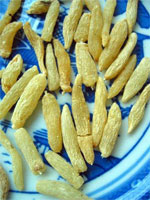 |
|
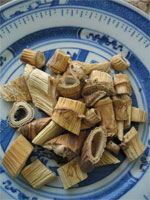 |
|
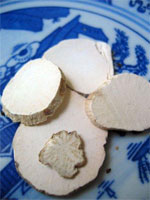 |
| Dwarf lily-turf |
|
Reed rhizome |
|
Snakegourd root |
Side effects associated with the esophagus
Patients may have difficulty in swallowing, mouth dryness, pain behind the sternum, or chest pain radiating to the back or shoulder. Physicians will aim at clearing heat and toxins, and also removing the stasis. Commonly used herbal ingredients are:
| pu gong ying |
Dandelion |
Herba Taraxaci |
| huang qin |
Baical skullcap root |
Radix Scutellariae |
| su geng |
Perilla stem |
Caulis Perillae |
| shi jian chuan |
Chinese sage herb |
Herba Salviae Chinensis |
| san chi |
Notoginseng |
Radix Notoginseng |
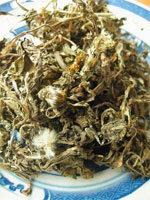 |
|
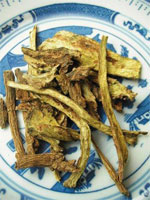 |
|
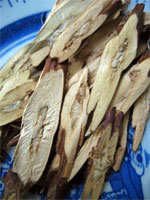 |
| Dandelion |
|
Baical skullcap root |
|
Perilla stem |
Side effects associated with the intestines
When the colon and rectum are affected and there is abdominal pain, diarrhea or blood in the stools, TCM believes that this indicates an accumulation of damp-heat in the region. The therapies will try to clear the damp-heat, cool down the blood, arrest bleeding and stop diarrhea. Commonly used herbal ingredients are:
| di yu |
Garden burnet root |
Radix Sanguisorbae |
| huai hua |
Pagoda tree flower |
Flos Sophorae |
| bai tou weng |
Chinese Pulsatilla root |
Radix Pulsatillae |
| ma chi xian |
Purslane herb |
Herba Portulacae |
| wu mei |
Smoked plum |
Fructus Mume |
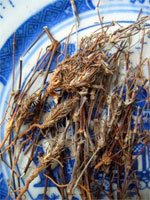 |
|
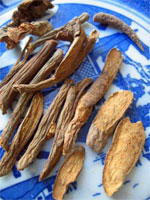 |
|
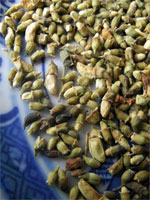 |
| Chinese Pulsatilla root |
|
Garden burnet root |
|
Pagoda tree flower |
Side effects associated with the bladder
When the urinary lining is irritated, urinary frequency, pain or bleeding will occur. Physicians will try to clear heat and toxins, cool down the blood, and induce a smooth, pain-free urination. Commonly used herbal ingredients are:
| sheng di |
Fresh rhemannia root |
Radix Rehmanniae |
| bai mao gen |
Lalang grass rhizome |
Rhizoma Imperatae |
| da ji |
Japanese Thistle herb |
Herba Cirsii Japonici |
| xiao ji |
Field Thistle herb |
Herba Cirsii |
| mu tong |
Akebia stem |
Caulis Akebiae |
Side effects associated with the skin
There are herbal creams to prevent skin reactions like redness, dryness or peeling, but certain herbs added to the prescription can have more beneficial results. Common herbal ingredients are:
| dang gui |
Angelica root |
Radix Angelicae Sinensis |
| shou wu |
Fleece flower root |
Radix Polygoni Mulitflori |
| shu di |
Processed rhemannia rhizome |
Rhizoma Rehmanniae Praeparatae |
| di fu zi |
Belvedere fruit |
Fructus Kochiae |
| dan pi |
Peony tree root bark |
Crotex Moutan Radicis |
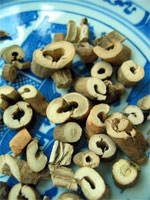 |
|
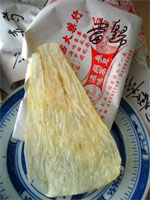 |
|
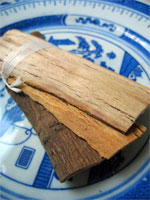 |
| Peony tree root bark |
|
Angelica root |
|
Red peony root |
|